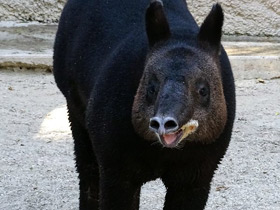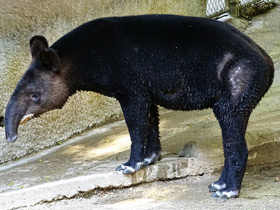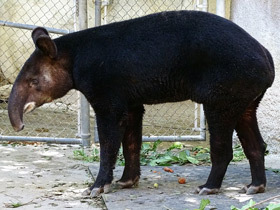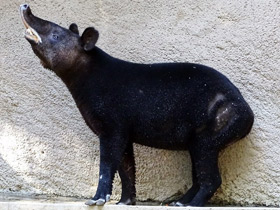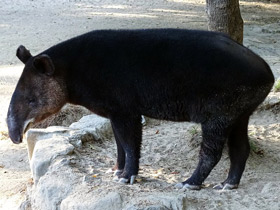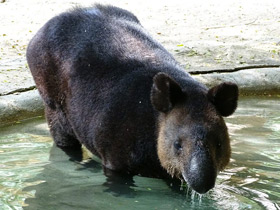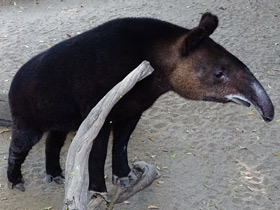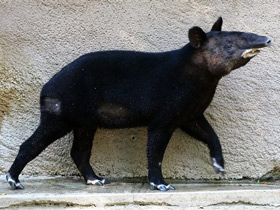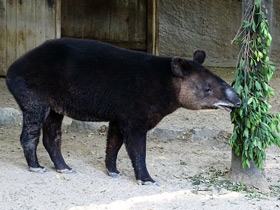The mountain tapir, also known as the Andean tapir or woolly tapir (Tapirus pinchaque)
The mountain tapir, also known as the Andean tapir or woolly tapir (Tapirus pinchaque) is the smallest of the four widely recognized species of tapir. It is the only one to live outside of tropical rainforests in the wild. It is most easily distinguished from other tapirs by its thick woolly coat and white lips.
The species name comes from the term "La Pinchaque", an imaginary beast said to inhabit the same regions as the mountain tapir.
Appearance and habitat
Tapirus pinchaque is a species of perissodactyl mammal of the tapir family. It is one of four species of tapir in the Americas, and the only one that lives outside of tropical rainforests in the wild. In Quechua it is known as sacha huagra.
Tapirus pinchaque is the smallest and slenderest of the tapirs, measuring only about 180 cm long and 75-80 cm at the withers, and weighing between 225 and 250 kg. Its coat, unlike that of other tapirs, is relatively soft, wavy and dense, dyed black or reddish brown, and the lips and tips of the ears are white. Its wool protects it from the cold and ultraviolet radiation at high altitudes. On the other hand, the skin is the thinnest of all tapirs. The body of the Tapirus pinchaque is bulky but slender, with four toes on each front foot and three on each hind foot.
The species has a limited range, being present only in the Andes of Colombia, Venezuela, Ecuador and northern Peru. Tapirus pinchaque lives in montane forests up to 2000-4500 m altitude and can even be found in the highland snowline.
Nutrition and lifestyle
Little is known about the lifestyle of Tapirus pinchaque. These animals are mainly active from dusk to early morning, resting in dense vegetation the rest of the time. These tapirs are remarkably agile and move with ease through the densest thickets. Like all tapirs, Tapirus pinchaque will undoubtedly climb fallen logs and is very fond of swimming. The Tapirus pinchaque often escapes from danger in the water. They are able to stay underwater for long periods of time, bringing their trunks to the surface of the water to breathe, which helps them to hide from their enemies. Tapirus pinchaque are herbivores and feed on leaves, twigs and other plant parts.
Behaviour
When around other members of their species, mountain tapirs communicate through high-pitched whistles, and the males occasionally fight over estrous females by trying to bite each other's rear legs. But for the most part, mountain tapirs are shy and lead solitary lives, spending their waking hours foraging for food on their own along well-worn tapir paths. Despite their bulk, they travel easily through dense foliage, up the steep slopes of their hilly habitats, and in water, where they often wallow and swim.
Mountain tapirs are generally crepuscular, although they are more active during the day than other species of tapirs. They sleep from roughly midnight to dawn, with an additional resting period during the hottest time of the day for a few hours after noon, and prefer to bed down in areas with heavy vegetation cover. Mountain tapirs forage for tender plants to eat. When trying to access high plants, they will sometimes rear up on their hind legs to reach and then grab with their prehensile snouts. Though their eyesight is lacking, they get by on their keen senses of smell and taste, as well as the sensitive bristles on their proboscises.
Males will frequently mark their territory with dung piles, urine, and rubbings on trees, and females will sometimes engage in these behaviors, as well. The territories of individuals usually overlap, with each animal claiming over 800 hectares (3.1 sq mi), and females tend to have larger territories than males.
Reproduction
During the breeding season, male Tapirus pinchaque fight over females by biting their hind legs with their sharp teeth. Gestation lasts between 390 and 400 days, after which one (rarely two) young are born. The newborn Tapirus pinchaque is born with its snout forward and its eyes open. It is able to walk shortly after birth and weighs between 4 and 7 kg. A young Tapirus pinchaque is cared for by its mother for 1 year, but the father does not participate in its life in any way. The colouration of young Tapirus pinchaque does not resemble that of adults: it is dark reddish brown with yellow and white stripes and spots. Young Tapirus pinchaque do not reach maturity until they are about one year old. They reach sexual maturity at 3 years of age and their lifespan is about 30 years.
Conservation status
Tapirus pinchaque is listed as endangered on the IUCN Red List. The total population of Tapirus pinchaque is estimated at 2500 animals and is the rarest of all tapirs. Competition with livestock is forcing it to abandon large parts of its range. Even national parks are now infiltrated by grazing cattle. The tapirus pinchaque is hunted for its meat, hooves and snout, which is used as a folk remedy for epilepsy and heart disease. Hunters and poachers get a lot of money for the body parts of the Tapirus pinchaque.
Evolution
The mountain tapir is the least specialised of the living species of tapir, and has changed the least since the origin of the genus in the early Miocene. Genetic studies have shown that mountain tapirs diverged from its closest relative, the Brazilian tapir, in the late Pliocene, around three million years ago. This would have been shortly after the formation of the Panamanian Isthmus, allowing the ancestors of the two living species to migrate southward from their respective points of origin in Central America as part of the Great American Interchange. However, the modern species most likely originated in the Andes, some time after this early migration.
Vulnerability
The mountain tapir is the most threatened of the five Tapirus species, classified as "Endangered" by the IUCN in 1996. According to the IUCN, there was a 20% chance the species could have been extinct as early as 2014. Due to the fragmentation of its surviving range, populations may already have fallen below the level required to sustain genetic diversity.
Historically, mountain tapirs have been hunted for their meat and hides, while the toes, proboscises, and intestines are used in local folk medicines and as aphrodisiacs. Since they will eat crops when available, they are also sometimes killed by farmers protecting their produce. Today, deforestation for agriculture and mining, and poaching are the main threats to the species.
There may be only 2,500 individuals left in the wild today, making it all the more difficult for scientists to study them. Also, very few individuals are found in zoos. Only a handful of breeding pairs of this species exists in captivity in the world — at the Los Angeles Zoo, the Cheyenne Mountain Zoo in Colorado Springs, and, as of 2006, the San Francisco Zoo. In Canada, a mating pair is kept in Langley, BC, at the Mountain View Conservation and Breeding Centre. The nine individuals in captivity are descendants of just two founder animals. This represents a distinct lack of genetic diversity and may not bode well for their continued existence in captivity. The three zoos that house this species are working to ensure that the remaining wild populations of mountain tapirs are protected. Two mountain tapirs were sent from San Francisco Zoo to Cali Zoo, making them be the only captive tapirs in their natural home range; one male is kept in Pitalito, it could be moved to the Cali Zoo to make a breeding pair.

















